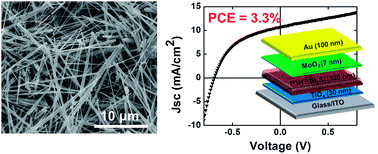Bi2S3 nanowire networks as electron acceptor layers in solution-processed hybrid solar cells†
Abstract
We report the assembly of Bi2S3 into percolated networks. Subsequent infiltration of poly(3-hexylthiophene), P3HT, as the electron donor generates an inorganic–organic active layer. Inverted solar cells fabricated with these active layers exhibit power-conversion efficiencies as high as 3.3%. To the best of our knowledge, this is the first example of a hybrid solar cell comprising a percolated network of single-crystalline Bi2S3 nanowires and P3HT.

- This article is part of the themed collection: 2022 Journal of Materials Chemistry Lectureship runners-up: Jessica Wade and Luisa Whittaker-Brooks

 Please wait while we load your content...
Please wait while we load your content...